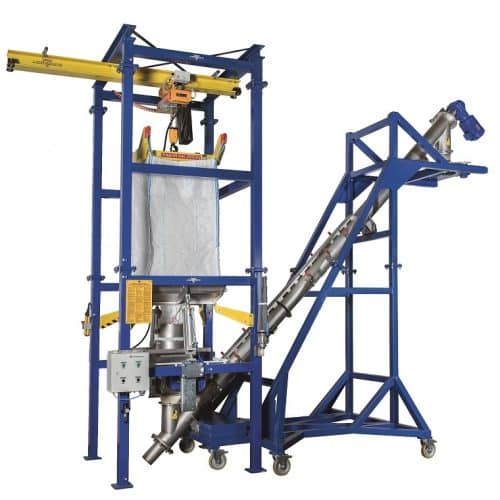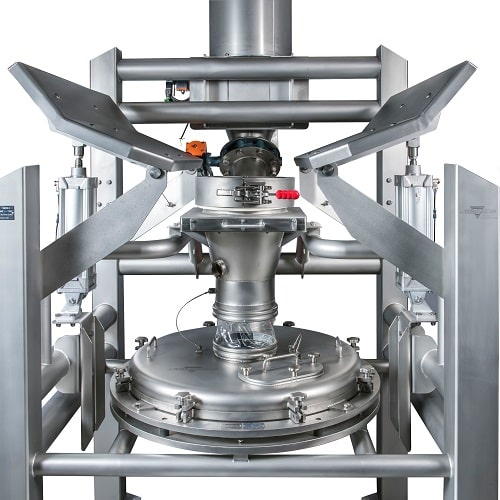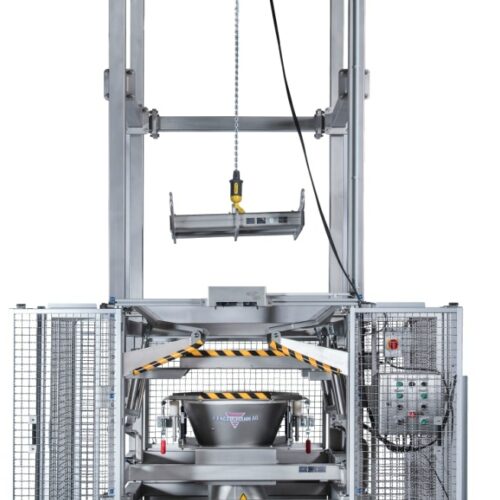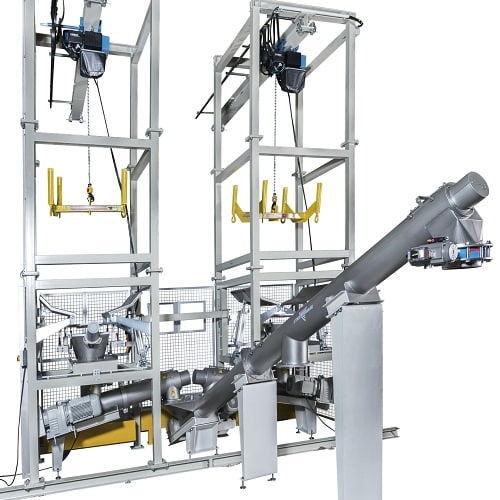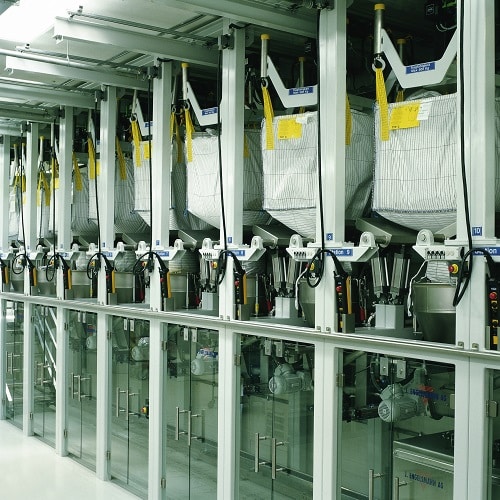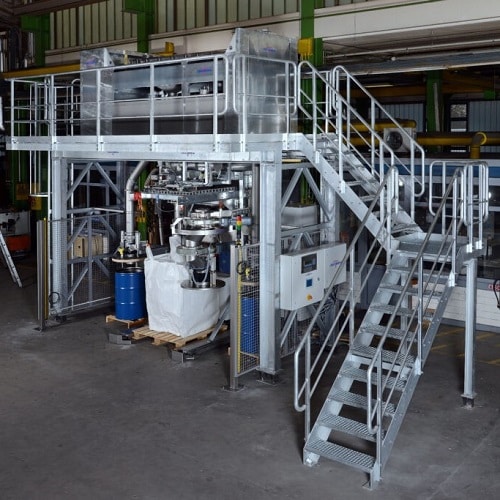What makes processing or emptying bulk solids particularly challenging?
The greatest challenge is the different material properties of the bulk solids. Many bulk solids tend to form dust, others have a high fat content, are abrasive or particularly sensitive to breakage. And not only different bulk solids have their peculiarities, even products that are actually identical can behave differently, depending on the specific conditions on site in the production plant.
An actually unproblematic bulk material can clump due to long transport distances or behave differently under the influence of high humidity and temperature than in an air-conditioned room. This, of course, has an impact on the equipment used and must be taken into account.
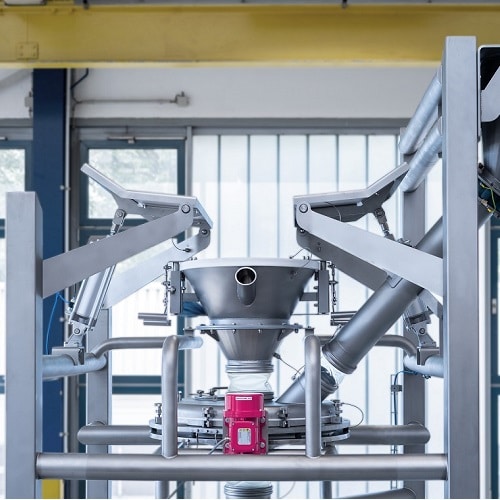
Hygienic big bag emptying of lactose
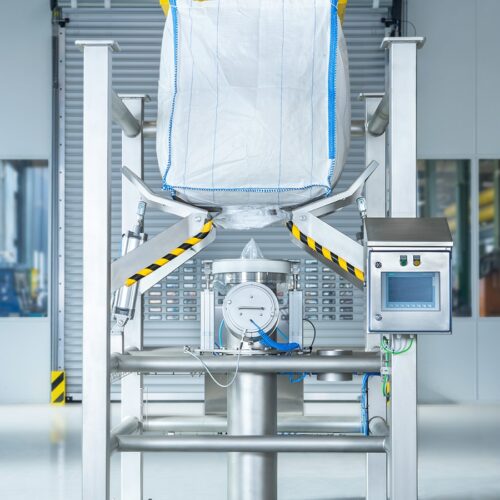
Big bag emptying in zones with containment up to OEB 4
What do I have to consider when choosing the right bulk material technology?
In order to ensure a smooth production process without unnecessary downtimes and, above all, to be able to call up the full performance potential of a machine, the technology used must be perfectly matched to the task and the product to be processed. Precise knowledge of the bulk material, the production process, and the general conditions on site are the basic prerequisites for ensuring that later discharge or even screening and mixing processes function optimally.
The easiest way to test these factors is in pilot plant trials: the customer provides the original product as a test material and the manufacturer replicates the process, testing and comparing different machine configurations. It is often the fine details of the machine settings that determine whether a specified throughput is achieved or not, for example. This is where the manufacturer’s know-how and wealth of experience are most in demand.




Electrostatic charging in plastics, strong dust generation, agglomerates and bridging due to contained fats, unfavorable shapes for a smooth product flow – the list of emptying challenges is long and requires product- and task-specific solutions.
What problems can occur when emptying bulk solids and how do users usually deal with them in practice?
Quickly, continuously and completely. Ideally, this is how a container should be emptied. Products that tend to form agglomerates can cause the discharge flow to stall if no or inadequate countermeasures are taken. Dusty products in combination with leaky systems or a leaky setting process can mean extreme dust exposure for the operator and the adjacent production environment.
It is also important that users not only keep an eye on the emptying itself, but also on downstream processes. For example, a compacting bulk material that can only be emptied from a container with the use of emptying aids probably cannot be conveyed to the next process step without problems. Additional equipment such as lump breakers or straining screens provide a remedy and can often be integrated directly into the discharge system in a space-saving manner.
What assistance and products do you offer the user for problem solving?
It is important that we first understand the customer’s task and plant environment before we can advise him and design solutions.
We have structured our product range in such a way that we can offer the right solution for as many tasks and bulk materials as possible. In the field of big bag emptying, we therefore use various concepts: from cost-effective systems for simple emptying tasks, to multifunctional solutions for demanding tasks, to emptying systems designed to meet customers’ specific needs. All systems are modular in design, so they can be equipped with additional options as required. We also offer solutions for emptying drums, sacks or containers.
As we also specialize in screening, mixing, conveying and dosing of bulk materials, we not only focus on the pure emptying process but also on upstream and downstream processes. In addition to stand-alone emptying stations, we therefore also design and manufacture complete plant units.
In order to offer the customer maximum process reliability, we often test the concepts we recommend. Pilot plant trials are an important component of our range of services and are gladly taken up by a large number of our customers. If it is not possible for the customer to visit us in Ludwigshafen in person, we can also transmit the test via a live stream if required.
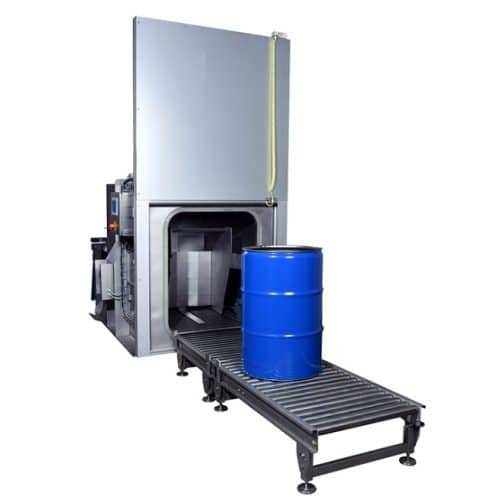
Drum emptying
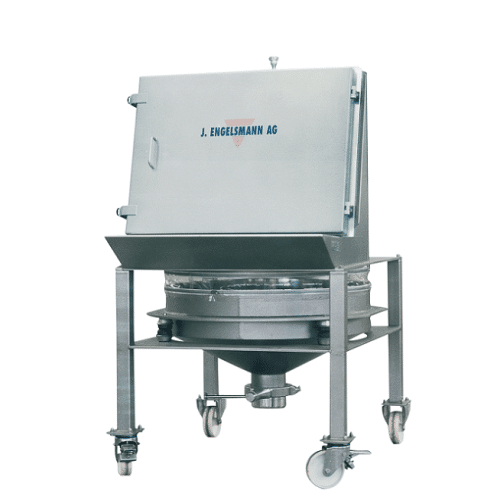
Emtying of small bags
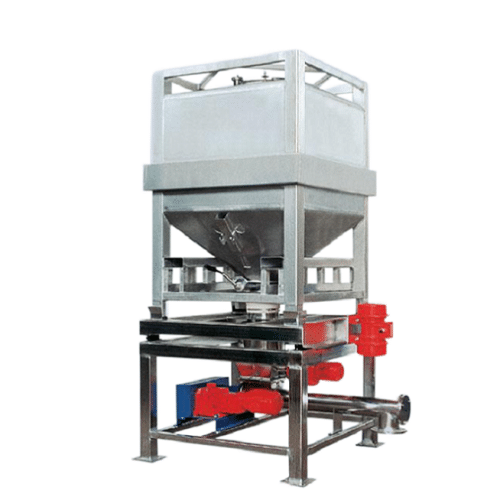
Container emptying stations
What developments are you currently observing in the field of bulk material emptying and where do you think the journey will go in the next few years?
We see that even customers from industries that until a few years ago hardly had to deal with the topic of hygienic emptying are approaching us. The requirements for hygienic processes and the equipment used are increasing overall. And with them, the demands on documentation and qualification of components, systems and entire plants.
The tightness of components is also playing an increasingly important role – keyword containment. The main driver of this trend is above all the fact that the products traded are becoming increasingly toxic, highly active and simply more dangerous for the operators of the corresponding systems. Engelsmann offers, for example, an emptying system for big bags for use in zones up to OEB 4. If required, it can be combined with a containment screening machine. In this way, a screening stage can be connected downstream of the discharge – while maintaining the containment throughout. However, we are observing the increasing demand for dust-tight solutions not only in this area of application. Wherever dusty products contaminate the plant atmosphere and endanger both the operators and the purity of the products, there is no longer any compromise when it comes to dust-tight equipment.
The increasing need for flexible solutions is another trend we are seeing. It must be possible to adapt machines or systems to changing conditions. This can only be achieved with modular solutions, which ideally also allow subsequent adjustments without having to dismantle the entire system.
In the emptying area, for example, we have implemented this with a station in which the conveying and metering elements can be easily changed during operation, depending on the product to be emptied.
More flexibility also means more mobility. The use of components at different points in production. Mobile production equipment that can be dismantled in just a few steps, easily moved from A to B, and reassembled at B. That is why we offer most of our machines with roller frames. A screening machine, for example, which can be flexibly docked to various big bag emptying stations in order to protectively screen the respective product directly after it has been emptied.
Flexibility is also required when filling big bags or drums. One operator, for example, wanted to be able to economically implement requests from his customers for different pack sizes. To this end, his existing big bag emptying line was to be supplemented by a mobile small container filling system – in the given space and without any structural changes.
In this case, flexibility means more function with a given footprint – another trend we are observing. Space is a scarce commodity for many plant operators, and no one can afford not to exploit productivity gains and cost-cutting potential. More and more often, the required process or functional scope and the floor space provided for it are the greatest challenge in our customer projects.


